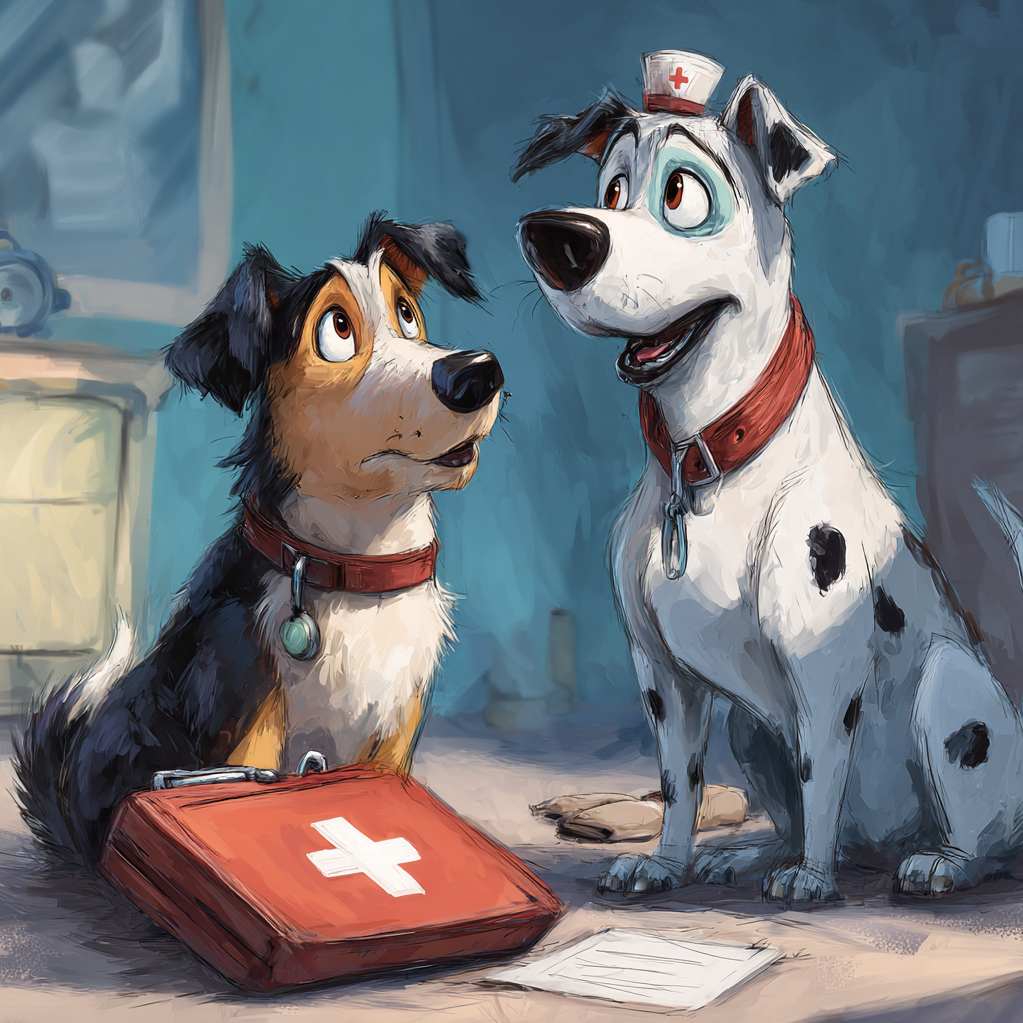The Unseen Agony: Navigating Your Dog’s Separation Anxiety with Clinical Insight and Compassionate Strategy
That subtle shift in your dog’s posture as you reach for your keys – the stiffening shoulders, the whites of the eyes showing, the breath held just a fraction too long – speaks volumes before a single whimper escapes. Separation Anxiety (SA) isn’t merely inconvenient; it’s a profound neurological distress response rooted in a dog’s perception of existential threat when isolated from their social anchor. Affecting roughly 1 in 5 companion dogs, this condition manifests not as disobedience, but as pure, unmitigated panic. As a veterinary behaviorist might explain, it’s the amygdala hijacking rational function, flooding the system with cortisol, compelling desperate acts born of terror, not malice. Recognizing this distinction is the first critical step toward effective management.

Decoding the Distress Signals: Beyond the Obvious Destruction
While shredded doorframes and vocal symphonies reported by neighbors are conspicuous, SA’s signature lies in its predictable sequence tied exclusively to the owner’s departure ritual and absence:
- The Pre-Departure Crescendo: Physiological changes often precede visible behavior. Note the subtle signs before you physically exit: excessive yawning (a displacement behavior), lip licking, trembling confined to the hindquarters, sudden immobility (“freezing”), or frantic scent-marking of your belongings. These are autonomic responses signaling acute stress activation.
- The Solo Crisis: Behaviors during isolation serve a desperate purpose:
- Barrier-Directed Destruction: Targeting doors/windows isn’t random vandalism; it’s a goal-oriented escape attempt fueled by panic. The depth of claw marks or tooth imprints in woodwork often correlates with the intensity and duration of the panic episode.
- Vocalization Patterns: True SA vocalizations aren’t territorial barks. Listen for the escalating pitch, repetitive phrasing, and duration exceeding 30 minutes continuously – hallmarks of distress calls, not boredom barks. Acoustic analysis often shows harmonic structures similar to canine distress vocalizations. Please note that 30 minutes is not a hard line. Clinical diagnosis is based on the pattern (tied specifically to absence) and type of vocalization.
- Elimination Anomalies: Urination or defecation inside, despite reliable housetraining, and crucially, often deposited on owner-scented items (beds, clothing) or directly against exit points. This reflects loss of bowel/bladder control under extreme stress or scent-soothing attempts.
- Ptyalism (Excessive Drooling): Puddles of saliva indicate intense autonomic nervous system arousal, far exceeding normal panting.
- Barrier-Directed Destruction: Targeting doors/windows isn’t random vandalism; it’s a goal-oriented escape attempt fueled by panic. The depth of claw marks or tooth imprints in woodwork often correlates with the intensity and duration of the panic episode.
- The Homecoming Paradox: The wildly exuberant, prolonged greeting isn’t just happiness; it’s decompression from extreme stress, often mixed with appeasement behaviors (“guilty look”) anticipating punishment for the destruction they sense but couldn’t control.
- The Velcro Effect: Constant shadowing reflects hypervigilance, not affection. The dog remains in a state of anticipatory anxiety, unable to achieve restful sleep or engage in independent activities for fear of sudden separation.
Etiology: Untangling the Web of Causation
Attributing SA to a single cause oversimplifies its neurobehavioral complexity. It’s typically a confluence:
- Neurobiological Vulnerabilities: Potential genetic factors influencing neurotransmitter regulation (serotonin, GABA pathways) or limbic system reactivity. Individual differences in stress hormone (cortisol) baseline and reactivity are measurable.
- Developmental Windows: The critical socialization period (3-14 weeks) isn’t just about meeting people/dogs; it’s about learning how to be alone safely. Puppies denied graduated, positive alone-time experiences during this phase lack the neural blueprint for coping. Premature separation (<8 weeks) disrupts vital dam-littermate bonding that teaches emotional regulation.
- Learned Helplessness vs. Hyper-Attachment: Contrary to popular belief, “spoiling” rarely causes SA. However, unpredictable owner availability (sometimes intensely interactive, sometimes abruptly absent) can prevent the dog from developing secure independence. The dog learns their behavior cannot influence the owner’s comings/goings, fostering anxiety.
- The Role of Traumatic Associations: A single intensely negative experience while alone (e.g., a smoke alarm sounding, a break-in attempt, a painful episode like bloat onset) can create a lasting, catastrophic association with solitude.
- Medical Mimics & Comorbidities: This cannot be overstated: A full veterinary workup is non-negotiable. Conditions like painful arthritis (making resting alone uncomfortable), cognitive decline in seniors (causing disorientation and panic) or idiopathic epilepsy (with subtle seizures manifesting as panic) must be ruled out or managed concurrently. Urinalysis and blood chemistry are essential baseline diagnostics.
Building the Scaffolding: Foundational Protocols Before Departure Training
Attempting absences without this groundwork is building on sand. Meticulous preparation is paramount:
- Veterinary Partnership: Go beyond a basic checkup. Provide your vet with detailed logs: videos of pre-departure behavior, duration alone before distress signs appear on camera, specifics of destruction/vocalization. Request diagnostics relevant to differentials (e.g., thyroid panel, urinalysis for infection/incontinence, pain assessment if older dog). This collaboration is foundational.
- Cue Desensitization – The Neuroscience Approach: Departure cues (keys, coat, bag) become classically conditioned fear stimuli. Systematic desensitization requires:
- Identify ALL Triggers: Does putting on specific shoes trigger more panic than others? Does picking up a purse vs. a backpack matter? Note subtle variations.
- Micro-Exposures with Habituation: Hold keys silently for 1 second while sitting calmly, place them down. Repeat 10x. Next session, jingle faintly once. Build imperceptibly over days/weeks. The goal is habituation – a neurological decrease in response through safe, repeated exposure without the feared outcome (departure). Monitor for subtle stress signals (ear position, pupil dilation, breathing rate).
- Arrival/Departure Neutrality – Operant Conditioning in Action: Your emotional state acts as a cue. The protocol:
- Pre-Departure (30-60 min prior): Enter a “neutral zone.” Cease all interaction with the dog. No talking, eye contact, or petting. Engage in mundane activities (reading, quiet chores). Gather departure items during this period and place them by the exit unobtrusively. Depart silently without fanfare.
- Post-Arrival Ritual: Enter silently. Acknowledge the dog with a calm, quiet word only after they have disengaged and are in a relaxed posture (e.g., lying down, not actively seeking attention). This utilizes differential reinforcement – rewarding calmness by withholding attention from excited states and providing it only for calm behavior. This rewires expectations.
- Cultivating Intrinsic Calm – The “Settle” Protocol: This isn’t just a command; it’s teaching emotional regulation.
- Phase 1: Use a specific mat/bed. Lure dog on, mark/reward for contact. Gradually shape duration (start with 3 seconds of stillness). Reward in position with low-value treats delivered calmly.
- Phase 2: Introduce the “Settle” cue only when the behavior is reliable. Gradually increase duration (use a timer) and minimally increase distance (e.g., take half a step back). Work towards the dog settling for 20-30 minutes while you read/work nearby without interaction. This builds neural pathways for self-soothing.
- Enrichment as Neuroprotection: Physical exertion lowers baseline cortisol. Mental enrichment builds cognitive resilience. Tailor rigorously:
- Pre-Departure Exercise: Not just a walk; structured aerobic activity (fetch, flirt pole, jogging) sufficient to induce panting before the cortisol spike of pre-departure anxiety begins.
- Cognitive Loading: Use puzzle toys requiring multi-step problem-solving (Nina Ottosson puzzles), scent work (hiding kibble in boxes), or short, reward-based training sessions focusing on impulse control (“Leave it,” “Wait”). This depletes mental energy constructively.
The Cornerstone Intervention: Desensitization and Counterconditioning (DS/CC) – A Neuroplasticity Protocol
DS/CC leverages the brain’s ability to rewire itself (neuroplasticity) by creating new, positive associations with the feared stimulus (being alone).
Phase 0: Threshold Determination & Baseline
- Crucial: Use a reliable camera (WiFi, records sound/motion).
- Identify True Threshold: The maximum duration alone where the dog shows ZERO signs of anxiety (no pacing, whining, panting beyond normal, lip licking, yawning, freezing). This could be 5 seconds or 5 minutes. This is your absolute starting point. Exceeding it reinforces fear. Record baseline behavior at this duration.
Phase 1: Sub-Threshold Absences – Rewiring the Amygdala
- Starting Duration: 50-75% of the known safe threshold. If threshold is 1 minute, start at 30-45 seconds.
- Protocol Execution:
- Ensure dog is physiologically calm (post-exercise/enrichment, settled).
- Perform neutralized departure routine.
- Depart calmly. Close door.
- Return BEFORE the threshold time expires. Example: If starting at 30 seconds, return at 25 seconds.
- Re-enter silently. Completely ignore the dog. Avoid even glancing in their direction.
- Wait 1-2 minutes of observed calmness (use camera upon return if needed). Then, calmly deliver an ultra-high-value reward (e.g., air-dried liver, real meat) non-contingently (not for performing a behavior, just for being calm). The reward follows the safe return, reinforcing “calmness during absence = amazing thing.”
- Progression: Increase duration by no more than 5-10% of the previous successful duration after 10 consecutive, flawless trials (no stress signals visible). Example: From 30 sec to 33 sec, then 36 sec. Use a timer religiously. This glacial pace is neurologically necessary. Rushing induces sensitization (worsening fear).
Phase 2: Introducing Predictable Positive Predictors (PPP)
- Timing: Begin once absences reach 2-3 minutes reliably.
- Method: Introduce a unique, long-lasting, high-value item only as you depart. Examples: A Kong frozen with a specific recipe (canned dog food, kibble, sweet potato – never given otherwise), a special collagen chew reserved solely for departures.
- Critical Rule: Remove the item immediately upon return, even if unfinished. This maintains its exclusive association with your absence and prevents satiation. Its purpose is to create a Pavlovian cue: “Owner leaving predicts this amazing thing,” shifting focus.
Phase 3: Generalization and Duration Building – Strengthening Neural Pathways
- Prerequisite: Dog tolerates 15-20 minutes alone with the PPP and shows calm return on camera.
- Strategies:
- Vary Departure Context: Practice departures at different times of day, using different doors, wearing different “outfits” (work clothes vs. gym clothes).
- Simulate Realistic Departures: Integrate the full pre-departure sequence (keys, coat, saying “be back later” to a family member) immediately before a departure within the current proven tolerance. Start short (e.g., full routine before a 5-min absence).
- Gradual Duration Increases: Continue the 5-10% increase rule based on camera-confirmed calmness. Monitor closely for regression when passing significant time markers (e.g., 30 mins, 1 hour).
Adjunctive Neuromodulation: Supporting the Process
These support DS/CC; they don’t replace it. Efficacy varies individually:
- Pheromonotherapy: Adaptil (DAP) diffuser/collar. Mimics the appeasing pheromone of lactating bitches. Modest effect in some dogs; requires continuous use. Place near the dog’s resting area.
- Nutraceuticals: Mechanisms often involve GABA modulation or serotonin precursor support. Require consistent dosing (4-6 weeks for effect):
- Alpha-casozepine (Zylkene): Hydrolyzed milk protein derivative, binds GABA-A receptors. Moderate evidence for reducing anxiety signs.
- L-Theanine & L-Tryptophan (Solliquin, Composure Pro): Amino acids influencing serotonin/dopamine. Mild calming effect in some.
- Magnesium L-Threonate: Crosses the blood-brain barrier; may support neuronal calming. Veterinary guidance on dosing is essential.
- Probiotics (e.g., Calming Care): Emerging research on the gut-brain axis (microbiome influencing anxiety). Requires long-term use.
- Pharmacological Intervention (Veterinary Prescription ONLY): Indicated for moderate-severe SA, dogs at risk of self-harm, or plateaued progress with DS/CC. Always paired with behavior modification.
- First-Line (SSRIs – Selective Serotonin Reuptake Inhibitors): Fluoxetine (Reconcile), Paroxetine. Require 4-8 weeks for full effect; daily administration. Increase synaptic serotonin, modulating mood and anxiety long-term.
- Second-Line (TCAs – Tricyclic Antidepressants): Clomipramine (Clomicalm). Also daily; affects serotonin/norepinephrine. May have more side effects (sedation, dry mouth).
- Adjunct/Situational (Anxiolytics/Sedatives): Trazodone, Gabapentin, Alprazolam. Used for specific predictable stressors (e.g., vet visits, unavoidable long absences during training). Onset within 1-2 hours.
The Imperative of Professional Guidance
Seek expertise when:
- Self-injury or severe property damage occurs.
- Progress plateaus despite rigorous DS/CC for 8+ weeks.
- The owner experiences significant distress or feels unable to implement the protocol.
- Underlying complex behavioral issues (e.g., noise phobia) coexist.
Qualified Practitioners:
- Veterinary Behaviorist (Dip ACVB): Board-certified veterinarians specializing in behavioral medicine. The optimal resource for diagnosis, complex cases, and medication management.
- Certified Applied Animal Behaviorist (CAAB or ACAAB): PhD or Masters-level specialists in animal behavior science. Excel in designing/modifying behavior plans.
- Fear Free Certified Professionals (Veterinarians/Trainers): Trained in low-stress handling and behavior modification protocols.
Endurance and the Neurology of Hope
Resolving separation anxiety is a testament to neuroplasticity – the brain’s capacity to change. It demands unwavering consistency, profound patience, and acceptance of non-linear progress. Setbacks are not failures but data points indicating a need for threshold recalibration. Celebrate microscopic victories: 45 seconds of calm silence, the first voluntary nap during a micro-absence. This journey reshapes not just the dog’s neural pathways, but deepens the human-animal bond through shared resilience and empathetic understanding. The ultimate reward transcends a clean doorway; it’s witnessing the profound peace of a dog who finally feels safe in their own solitude.




